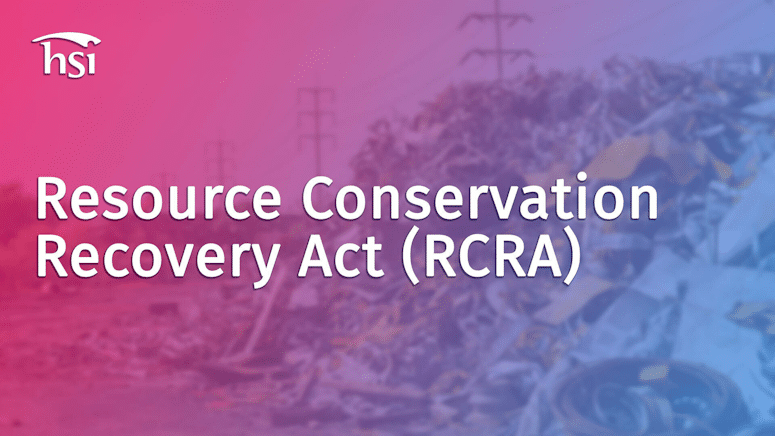The Resource Conservation and Recovery Act (RCRA, pronounced RIK-rah) is a federal law that governs the care of hazardous waste to protect human health and the environment. October 21, 1976 – RCRA established a structure for the regulation of hazardous and non-hazardous solid waste. It was an answer to concerns about the environmental and health impacts of growing waste generation.
Historical Context
During the late 1960s and early 1970s, a new kind of environmental consciousness emerged in the U.S. with widespread public concern about water pollution, oil spills (including Santa Barbara) and air quality issues like smokestack emissions in major American cities like Charleston.
Not until 1970, when Rachel Carson published Silent Spring and the first Earth Day was held in response to growing public concern over pollution and waste management, did our day-to-day lives change. The environmental movement worked closely over a short period of time, establishing key regulatory bodies like the EPA in 1970. It was increasingly evident by the mid-1970s that current legislation could not deal with emanated waste study cradle-to-grave, and implementation of the RCRA ensued.
Key Provisions of the RCRA
The RCRA codified a wide variety of statutes aimed at managing waste from the time it is generated until its ultimate disposal. Key components include:
Cradle-to-Grave Management: RCRA created a comprehensive “cradle-to-grave” system of hazardous waste management. This entails tracking hazardous wastes all the way from production (generation) to treatment and containment, and culminates in their ultimate disposal. Regulations governing the handling and documentation are very strict and all generators of hazardo us waste must have their own regulations to follow.
Classification of waste as hazardous waste: The act establishes criteria for classifying a waste as hazardous. It also contains lists of specific hazardous wastes and characteristics such as ignitibility, corrosivity, reactivity, or toxicity. This system classifies wastes that need to be managed in special ways.
Permits & Standards: RCRA requires hazardous waste TSDFs to obtain permits from the EPA or authorized state authorities. These permits are designed to ensure these facilities meet strict environmental standards to prevent air, water and soil pollution.
Solid Waste Management: Along with hazardous waste, RCRA also controls non-hazardous solid waste. In addition, it urges states to make comprehensive litter control plans and initiates programs to reduce waste and encourage recycling.
State Flexibility and Authority: In the same way that RCRA authorizes state initiatives, it allows states to implement their own hazardous waste management program as long as they are consistent with federal regulations. It allows states to adopt approaches that are adapted to suit local needs and conditions.
Citizen Involvement: This act recognizes that the public participation is paramount to waste management decisions. Right to information about the activities of hazardous waste law and citizen involvement in permitting
Impact and Achievements
RCRA has been instrumental in shaping the way wastes are managed across the U.S. and waste management practices since its enactment. The legislation also paved the road for national standards regarding mismanaged hazardous waste, which in turn had safer practices and a lowered health risk in its wake. RCRA created a structure of resource conservation programs that provides guidance for states to improve local waste management infrastructure, and to promote best management practices for the environment.
RCRA has also been a stimulus for many innovations in waste management, such as recycling and waste minimization. It has generated measures to encourage the thinking about waste as a resource. Expand on that philosophy, and you have the EPA’s “Reduce, Reuse, Recycle” hierarchy that was instigated as a reflection of RCRA.
Challenges and Limitations
Despite its reputation for success and a voluminous corpus of dense regulations RCRA has been proven as an ongoing challenge. Although the act was an important piece of progressive legislation focusing on solid and hazardous waste management, new types of waste such as electronic waste and pharmaceutical waste pose emerging issues that demand fresh regulations and potential programmatic changes.
In addition, the application of RCRA can differ greatly from state to state. Other states may have very well-designed programs on the books, but limited resources and direct service capacity. This mismatch can drive holes in waste management and enforcement.
Moreover, the legislation is regulation-driven and compliance-centric which could impede original waste management solutions. The impact would have gone too far, some critics argue, with a more flexible approach that permits creative solutions able to improve waste-reduction efforts.
Future Directions
Beyond the immediate horizon, RCRA will have to accommodate changes in the waste management landscape. This includes tackling emerging waste streams, increasing recycling, and driving sustainable practices across sectors. The promotion of circular economy (CE), in which waste is minimized by reusing resources at each stage, is essentially linked to the original model expressed by RCRA and at the same time an innovation opportunity.
Given the rising environmental awareness, RCRA still serves as a crucial instrument in the U.S. government’s trash stewardship efforts. By promoting cooperation on a federal, state and local level as well as by bringing the public into waste management decisions, RCRA will keep on safeguarding human health and the surroundings for some years more.
The Resource Conservation and Recovery Act of 1976 is a cornerstone of US environmental law that set out the write to control created into hazardous waste by open dumping, treatment or storage before disposal. Thus, RCRA has contributed handsomely through the framework it sets out for hazardous and solid waste management in protecting public health and the environment. RCRA will continue to be an important tool in the realm of waste management and sustainability even as the landscape of waste management grows and changes.
